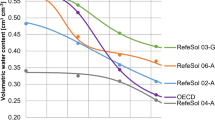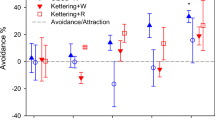Abstract
Earthworm preference tests, especially in soil-dosed exposures, can be an informative tool for assessing land management practices. Agricultural management intended to increase crop yield and improve soil sustainability includes physical manipulation of topsoil through conventional tillage, reduced or no-tillage, and/or winter cover crops. Soil amendments include the addition of inorganic nitrogen or organic nitrogen derived from soil amendments including biosolids from sewage treatment plants, poultry litter, or locally available industrial effluent. This study used 48-h Eisenia fetida preference tests to assess impacts of agricultural management practices on soil macrofauna. Although in laboratory-dosed exposures, E. fetida preferred biosolid-dosed soils (80 %–95 % recovery) over control soils, the same results were not found with field soils receiving biosolid amendments (33 % recovery). Poultry litter-amended soils (68 % recovery) were preferred over control soils. No differences were measured between tilled fields and controls, and earthworms preferred control soils over those from fields with no-tillage and cover crops. Soil assessments through laboratory exposures such as these allows science-based agricultural management decisions to maintain or improve soil health.




Similar content being viewed by others
References
Artuso N, Kennedy TF, Connery J, Grant J, Schmidt O (2010) Effects of biosolids at varying rates on earthworms (Eisenia fetida) and springtails (Folsomia candida). Appl Environ Soil Sci. doi:10.1155/2011/519485
Artuso N, Kennedy TF, Connery J, Grant J, Schmidt O (2011) Assessment of biosolids in earthworm choice tests with different species and soils. Glob Nest J 13(3):255–265
Bouldin JL, Warby RAF, Yu P, Teague TG (2011) Sustainable cotton production: the effects of best management practices on water, sediment and soil quality. In: Derrick M. Oosterhuis (ed) Summaries of Arkansas cotton research 2010, Arkansas agricultural experiment station research series 589, pp 100–105. http://arkansasagnews.uark.edu/1356.htm
Carpenter-Boggs L, Kennedy AC, Reganold JP (2000) Organic and biodynamic management: effects on soil biology. Soil Sci Soc Am J 64:1651–1659
Clapperton JM, Miller JJ, Larney FJ (1997) Earthworm populations as affected by longterm tillage practices in southern Alberta, Canada. Soil Biol Biochem 29(3, 4):631–633
Congreves KA, Hayes A, Verhallen EA, Van Eerd L (2015) Long-term impact of tillage and crop rotation on soil health at four temperate agroecosystems. Soil and Tillage Res 152:17–28. doi:10.1016/j.still.2015.03.012
Environment Canada (2004) Biological test method: tests for toxicity of contaminated soil to earthworms (Eisenia andrei, Eisenia fetida, or Lumbricus terrestris). Method development and applications section. Environmental Technology Centre. Ottawa, Ontario. Report EPS 1/RM/43
Espinoza L (2008) Grain Sorghum production handbook. University of Arkansas, Division of Agriculture, Cooperative Extension Service. Fertilizer recommendations – medium testing clay loam soil
Garg P, Gupta A, Satya S (2006) Vermicomposting of different types of waste using Eisenia foetida: a comparative study. Bioresour Technol 97:391–395
Huguier P, Manier N, Chabot L, Buada P, Pandard P (2015) Ecotoxicological assessment of organic wastes spread on land: towards a proposal of a suitable test battery. Ecotoxicol Environ Saf 113:103–111
Jongmans AG, Pulleman MM, Balabane M, van Oort F, Marinissen JCY (2003) Soil structure and characteristics of organic matter in two orchards differing in earthworm activity. Appl Soil Ecol 24(3):219–232
Lima ACR, Hoogmoed W, Brussaard L (2008) Soil quality assessment in rice production systems: establishing a minimum data set. J Environ Qual 37:623–630
Lukkari T, Haimi J (2005) Avoidance of Cu- and Zn-contaminated soil by three ecologically different earthworm species. Ecotoxicol Environ Saf 62(1):35–41
Marques C, Pereira R, Goncalves F (2009) Using earthworm avoidance behaviour to assess the toxicity of formulated herbicides and their active ingredients on natural soils. J Soils Sediments 9(2):137–147
Motalib AM, Rida A, Bouché MB (1997) Earthworm toxicology: from acute to chronic tests. Soil Biol Biochem 29(3/4):699–703
Natal-da-Luz T, Tidona S, Jesus B, Morais PV, Sousa JP (2009) The use of sewage sludge as soil amendment. The need for an ecotoxicological evaluation. J Soils Sediments 9(3):246–260
Paoletti MP (1999) The role of earthworms for assessment of sustainability and as bioindicators. Agric Ecosyst Environ 74:137–155
Schaefer M (2004) Assessing 2,4,6-Trinitrotoluene (TNT)-contaminated soil using three different earthworm test methods. Ecotoxicol Environ Saf 57(1):74–80
Shepppard SC, Bembridge JD, Holmstrup M, Posthuma L (1998) Advances in earthworm ecotoxicology. In: Proceedings from the second international workshop on earthworm ecotoxicology. 2–5 April 1997. Amsterdam, The Netherlands. Pensacola FL: Society of Environmental Toxicology and Chemistry, p 9
Slimak KM (1997) Avoidance response as a sublethal effect of pesticides on Lumbricus terrestris (Oligochaeta). Soil Biol Biochem 29(3/4):713–715
Spurgeon DJ, Svendsen C, Rimmer VR, Hopkin SP, Weeks JM (2000) Relative sensitivity of lifecycle and biomarker responses in four earthworm species exposed to zinc. Environ Toxicol Chem 19:1800–1808
Stephenson GL, Kaushik A, Kaushik NK, Solomon KR, Steele T, Scroggins RP (1998) Use of an avoidance-response test to assess the toxicity of contaminated soils to earthworms. Advances in earthworm ecotoxicology. Soc Environ Toxicol Chem Press, Pensacola, FL
Syers JK, Springett JA (1984) Earthworms and soil fertility. Plant Soil 76:93–104
Web Soil Survey (2016) http://websoilsurvey.sc.egov.usda.gov/
Yeardley RB Jr, Lazorchak JM, Gast LC (1996) The potential of an earthworm avoidance test for evaluation of hazardous waste sites. Environ Toxicol Chem 15(9):1532–1537
Zibilske LM, Bradford JM (2007) Soil aggregation, aggregate carbon and nitrogen, and moisture retention induced by conservation tillage. Soil Sci Soc Am J 71:793–802
Acknowledgments
The authors would like to acknowledge funding from the Midsouth/Southeast Bioenergy Consortium award #DE-FG36-08GO88036 and Cotton Incorporated. We acknowledge Lisa Ellington at Paragould Wastewater Treatment Plant and Mannco Fertilizer, Inc. for contributing the biosolids for these exposures. Special thanks to Dr. Tina Teague, Judd Hill and Ecotoxicology Research Facility personnel, especially Alex Barnett for his assistance.
Author information
Authors and Affiliations
Corresponding author
Rights and permissions
About this article
Cite this article
Bouldin, J.L., Klasky, J.W.P. & Green, V.S. Earthworm Preference Bioassays to Evaluate Land Management Practices. Bull Environ Contam Toxicol 96, 767–772 (2016). https://doi.org/10.1007/s00128-016-1744-4
Received:
Accepted:
Published:
Issue Date:
DOI: https://doi.org/10.1007/s00128-016-1744-4




